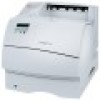Lexmark T620 Setup Guide - Page 27
Local printing, optional USB/Parallel Interface Card, you need - parts
 |
View all Lexmark T620 manuals
Add to My Manuals
Save this manual to your list of manuals |
Page 27 highlights
- Token-Ring networks (Shielded Twisted Pair) use a DB9 connector. - Ethernet 10Base2 networks (Thin Coax) use a BNC T-connector. Local printing You can attach your printer locally using either the standard USB port or parallel port. A USB port is standard on all printer models. We recommend Lexmark USB cable part number 12A2405 (2 m). The standard parallel port requires an IEEE-1284 compliant parallel cable. We recommend Lexmark parallel cable part number 1329605 (10 ft) or 1427498 (20 ft). If you add a parallel port by installing an optional USB/Parallel Interface Card, you need a 1284 A-C parallel cable, such as Lexmark part number 43H5171 (9.8 ft). Note: Some UNIX, Linux, and Macintosh computers also support USB connections. Consult your computer documentation to see if your system supports USB. If you have installed an optional Tri-Port Adapter, or if you are using a non-network 25















